Minnesota State Patrol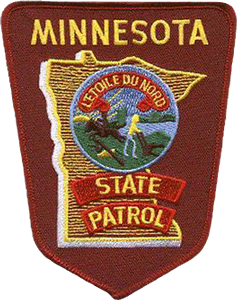
Minnesota State Patrol
The Minnesota State Highway Patrol was formed in 1929, as there was a need for an agency with statewide jurisdiction in traffic enforcement. The original force was comprised of 35 men at a salary of $120 per month.
These new troopers also had to furnish their own motorcycles for patrol. From 1929 to 1969, the MSHP was under the control of the Minnesota Department of Highways. 1931 saw the ranks of the Patrol increase to 70 officers and the second academy was held. Ford Model A's were used for patrolling in the winter months and motorcycles were used primarily at all other times in those early days.
The Patrol adopted the maroon and gold colors of the University of Minnesota, and the tradition has been maintained ever since. By 1941, the Patrol was up to 126 men, and by 1955 that number jumped to 255, and then 330 by 1957. In 1967, the MSHP became part of the newly created Minnesota Department of Public Safety, and the manpower was up to 458 officers.
Up until 1971, MSHP authority extended only to crimes committed on state trunk highways. That year, jurisdiction was given to the Patrol to arrest for crimes committed in their presence anywhere in the state.
In 1974, the name Minnesota State Patrol became the official by dropping the word "Highway" from the monicker. In 1986, District 4700 commenced operation which was the Commercial Vehicle Enforcement Division. Today, the Minnesota State Patrol is comprised of 11 patrol districts located in Rochester, Mankato, Marshall, Oakdale, Golden Valley, St. Cloud, Duluth, Brainerd, Detroit Lakes, Virginia, and Thief River Falls.
Each District is divided into geographic work areas referred to as "stations". There are a total of 61 stations throughout the state. The State Patrol has 810 total personnel, of which 522 are uniformed and 288 are civilian.
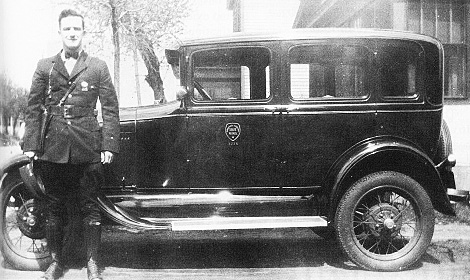
There is little confirmed data or photographs indicating the license plate usage by the Minneota State Patrol in its earliest years, however some partially obscured photos from the early 1930's indicate use of Tax Exempt license plates. The plates were issued and valid for three year blocks. It can be surmised that the MSP ran these 3-year Tax Exempt plates since their formation in 1929, therefore each type since 1929 will be showcased here.
It has also been stated that MSP cars were also outfitted with a large 4 to 5 inch, five-pointed brightly-colored metal star mounted above the front license plate.
 1927-1929 issue. Embossed steel.
1927-1929 issue. Embossed steel.

The photo just above shows the confirmed use of the Tax Exempt license plate being run on the 1930 Ford patrol car of Patrolman Robert C. Newmann in 1934. The license plate run on this car would have been made of embossed steel and measuring 5 1/4" x 11 3/4". The top line would have read TAX EXEMPT-33-5 and the abbreviation MINN ran stacked down the right side of the plate. The registration number appears to be 526.
(Courtesy of J. Hansen via home.comcast.net/~sgtsletten/site/)
The 1930-1932 issue before this would have similarly been: Embossed steel. 5 1/2" x 12". Yellow over dark green. MINN embossed vertical along left. TAX EXEMPT- 30-32 (over) number up to 3 digits.
 1933-1935 issue: Embossed steel.
1933-1935 issue: Embossed steel. 
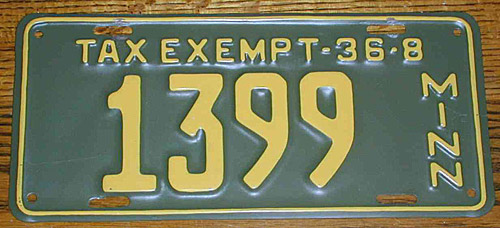 1936-1938 issue: Embossed steel.
1936-1938 issue: Embossed steel. 
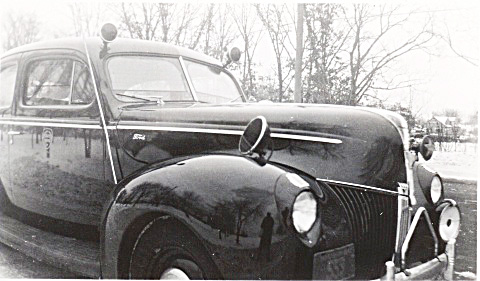 (Photo above and next few below of MSP cars courtesy of home.comcast.net/~sgtsletten/site/)
(Photo above and next few below of MSP cars courtesy of home.comcast.net/~sgtsletten/site/)
1939-1941 issue: Embossed steel. 5 1/2" x 12". Yellow over dark green. MINN embossed vertical along right. TAX EXEMPT- 39-41 (over) number up to 4 digits.
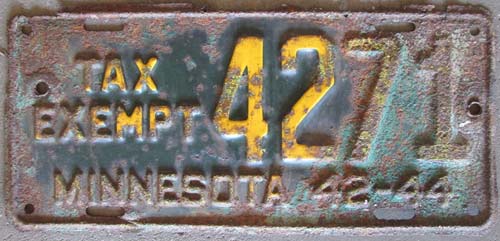 1942-1944: Embossed steel.
1942-1944: Embossed steel. 
 1945-1947: Embossed steel.
1945-1947: Embossed steel. 
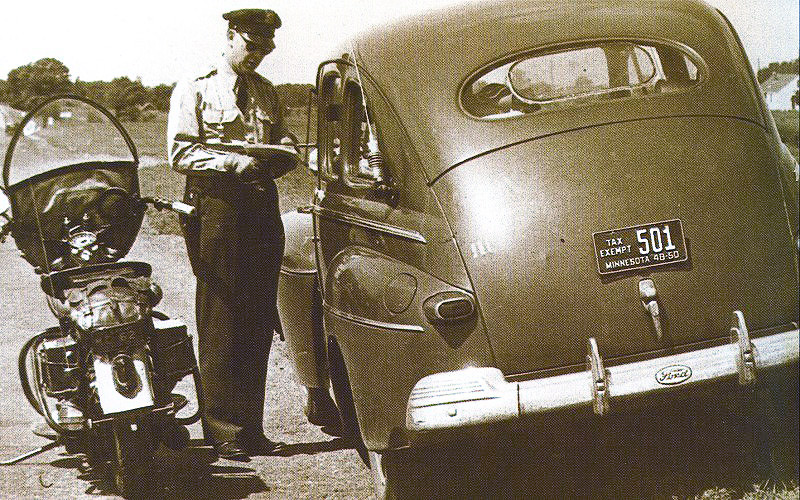
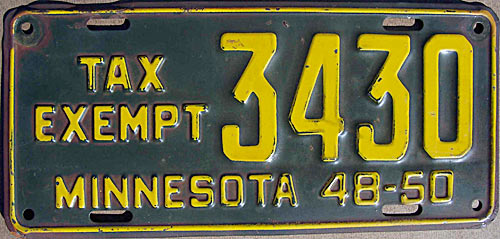 1948-1950 issue: Embossed steel.
1948-1950 issue: Embossed steel. 
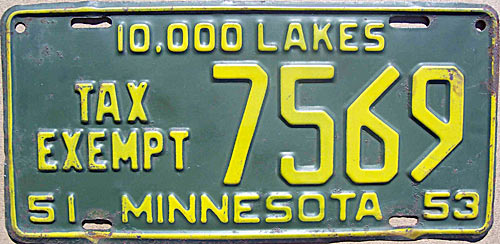 1951-1953 issue: Embossed steel.
1951-1953 issue: Embossed steel. 
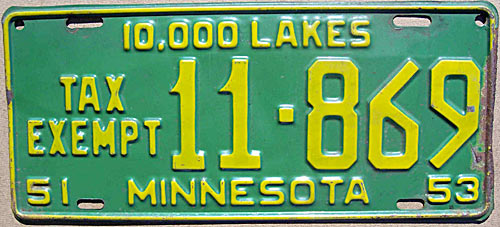 1951-1953 five digit issue:
1951-1953 five digit issue: 

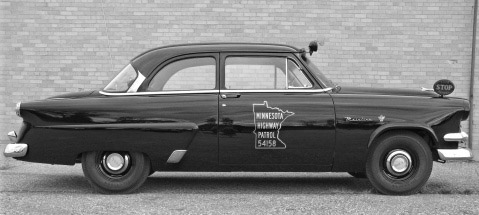
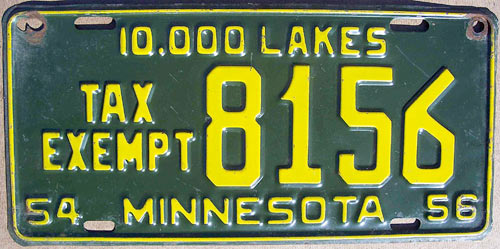 1954-1956: Embossed steel.
1954-1956: Embossed steel. 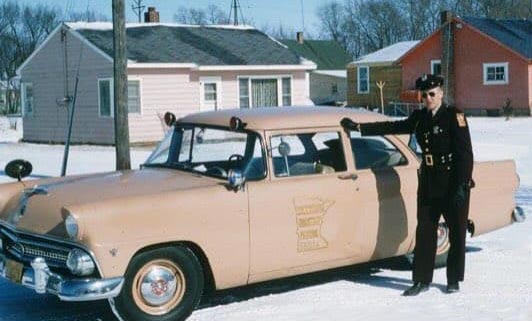
 1957-1959 issue:
1957-1959 issue: 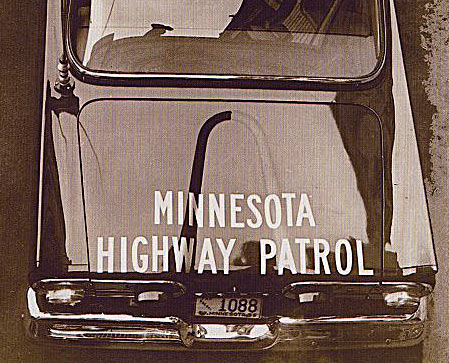
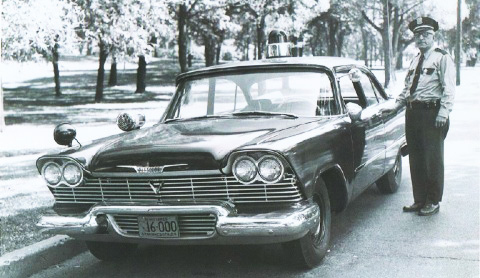
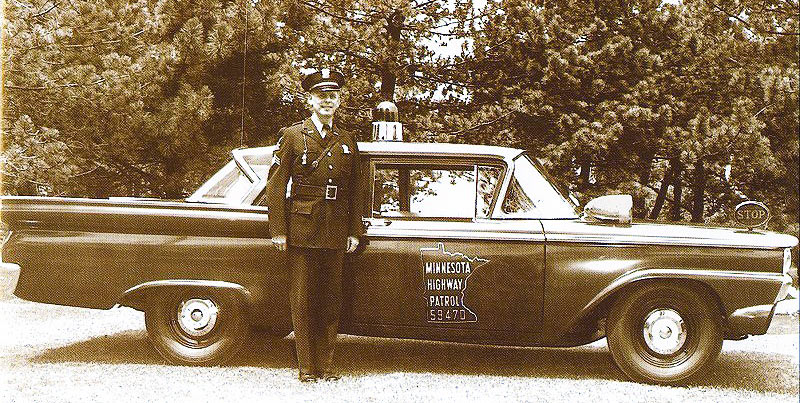
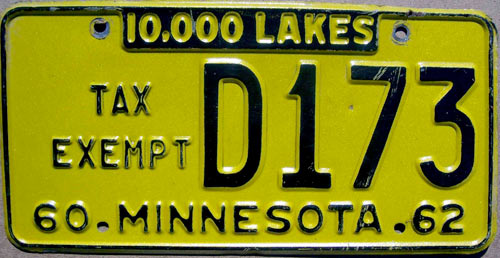 1960-1962 issue:
1960-1962 issue: 
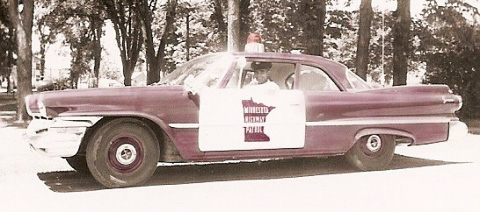
In the early 1960's, the MSP began using more passenger series license plates concurrent with the Tax Exempt issues. This practice had commenced in the 1950's, but by the 1970's, it appears that the MSP deployed more passenger car plates than Tax Exempt ones.
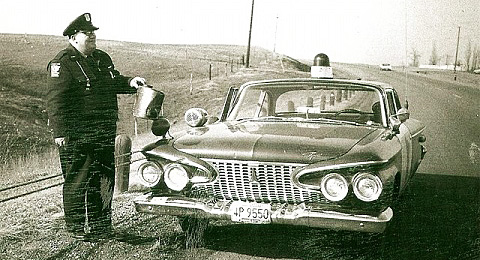
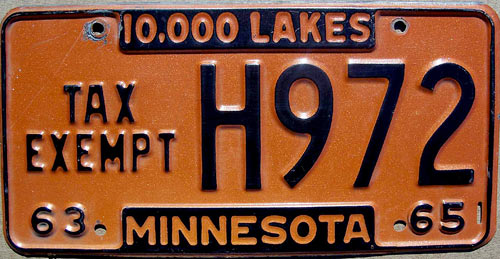 1963-1965 issue.
1963-1965 issue. 
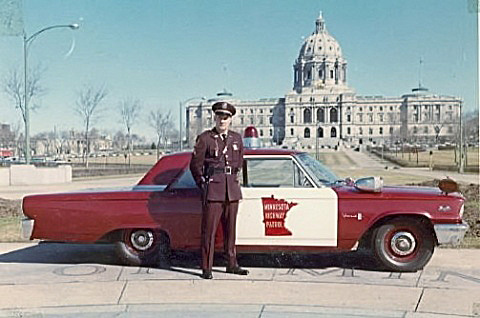
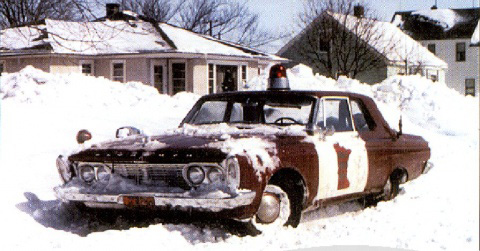
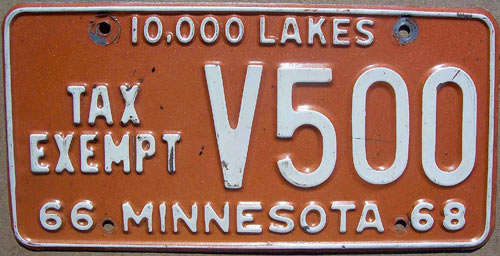 1966-1968 issue.
1966-1968 issue.  (Courtesy Willie Brown).
(Courtesy Willie Brown). 1969-1971 issue.
1969-1971 issue. 
By the late 1960's/early 1970's, it appeared based on photographic evidence that the lion's share of MSP marked patrol cars were issued and ran passenger series license plates which were updated with annual validation decals. Most passenger version license plates used by the MSP appeared to be in the M series from 1968 until at least 1973.
Therefore, passenger plates in this series are showcased along with the Tax Exempt versions of this period.
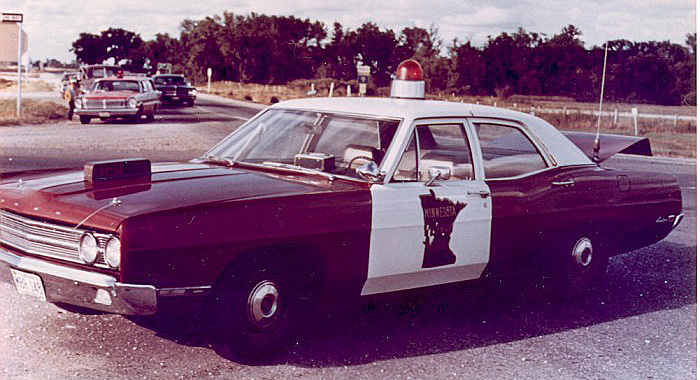
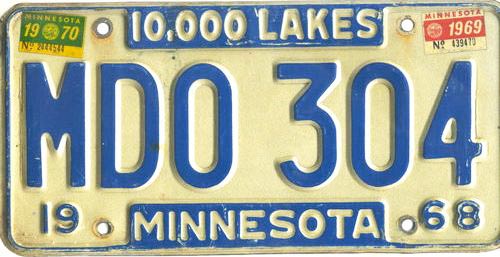 1968-1970 passenger issue.
1968-1970 passenger issue. 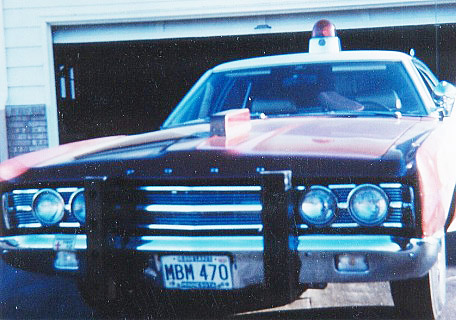 (Courtesy of home.comcast.net/~sgtsletten/site/)
(Courtesy of home.comcast.net/~sgtsletten/site/) 1969- Same Patrol Car (19039) as seen below.
1969- Same Patrol Car (19039) as seen below.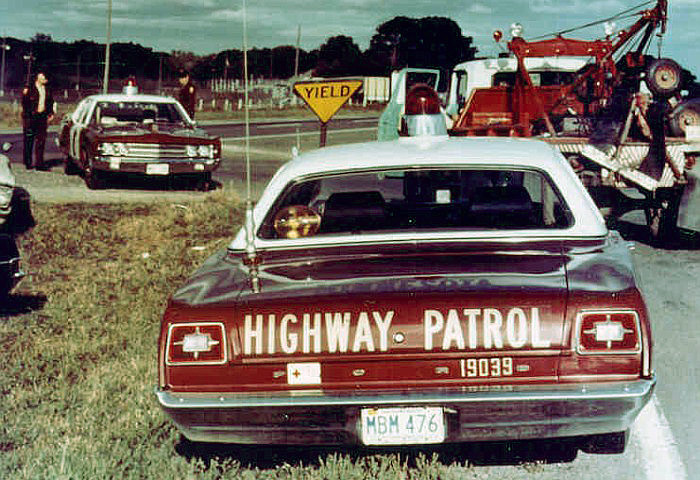
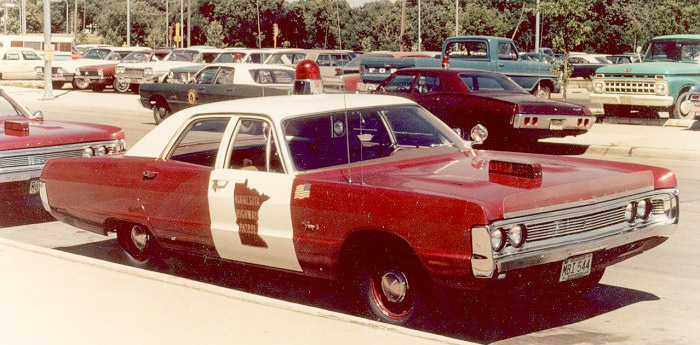
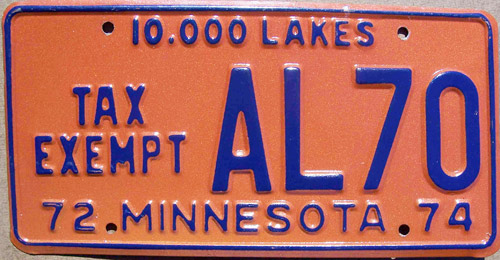 1972-1974 issue.
1972-1974 issue. 
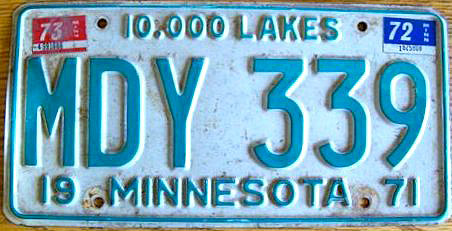 1971-1973 passenger issue.
1971-1973 passenger issue. 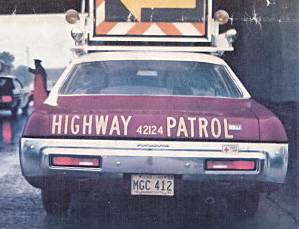
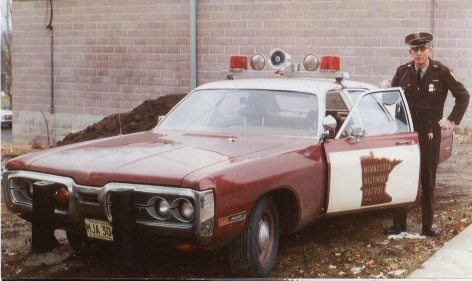
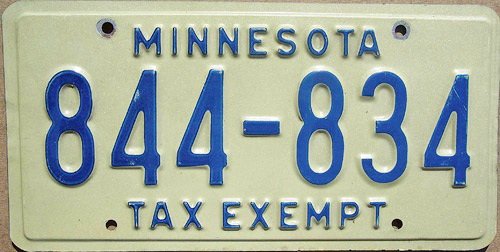 1975-circa 1977 issue.
1975-circa 1977 issue. 
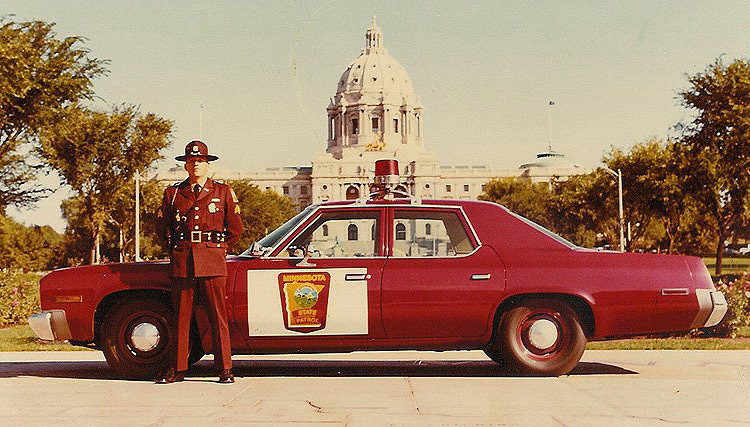
An exact date is unknown so far, but around 1977, the Minnesota State Patrol introduced an attractive graphic license plate for use on the agency's marked patrol vehicles.
The plates were made of flat aluminum and silkscreened in maroon over reflective gold.
The plate featured a detailed image of the MSP breast badge situated on the left side of the plate centered between the upper and lower left mounting holes of the plate. To the right of the badge is the title STATE over TROOPER. The plate also has a maroon border outline.
Many of these plates have particulars of the assignment of the plate to the particular trooper's vehicle inscribed in black marker on the backside. The inscription usually appears as SP and the badge number of the trooper. A five digit "Squad number" beginning with the number 4 which is the state auditor's code for the MSP. The second digit is the year code- For example a Squad Number of 49235 would indicate an MSP vehicle of 1979 model year and 235 would be the 235th vehicle of the line.
These plates were used until approximately 1983.
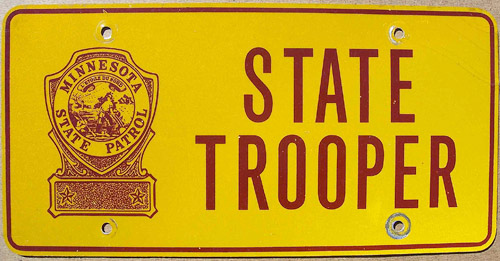 Circa 1977-1983 issue.
Circa 1977-1983 issue. 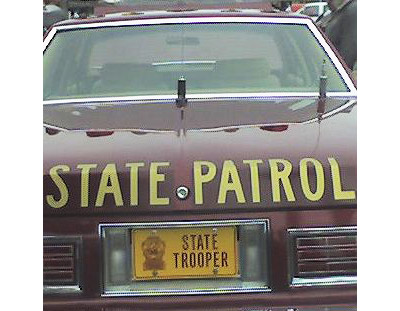
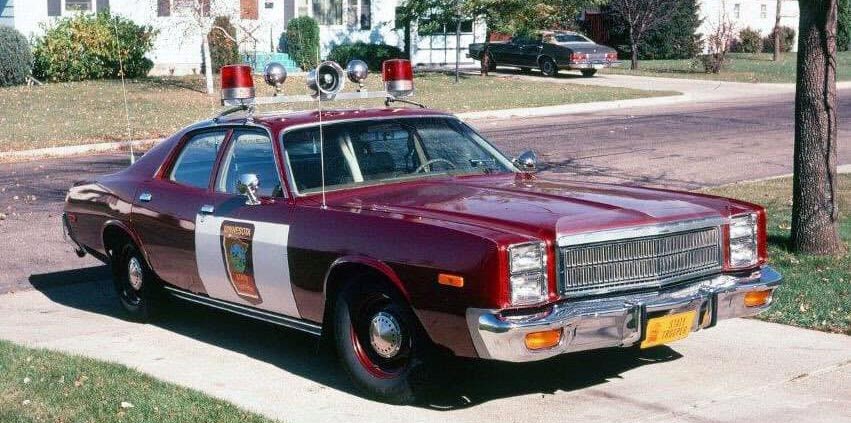 (Courtesy Willie Brown)
(Courtesy Willie Brown)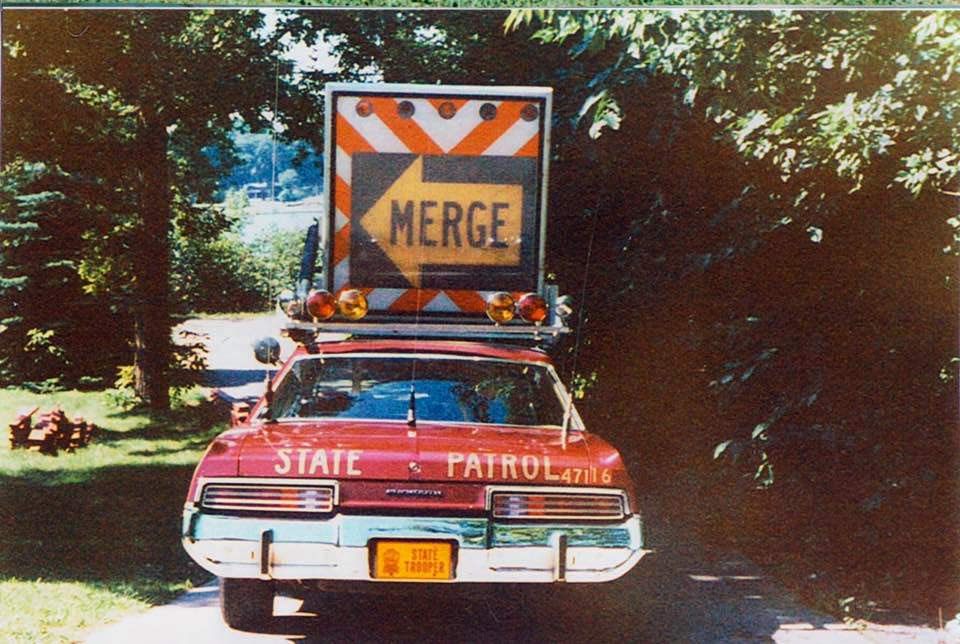 (Courtesy Jay Sletten)
(Courtesy Jay Sletten)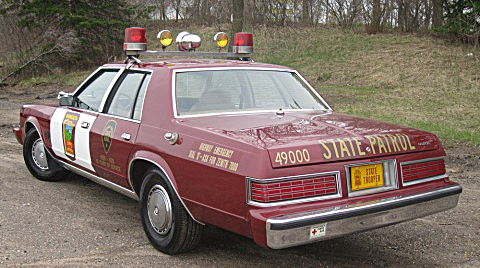
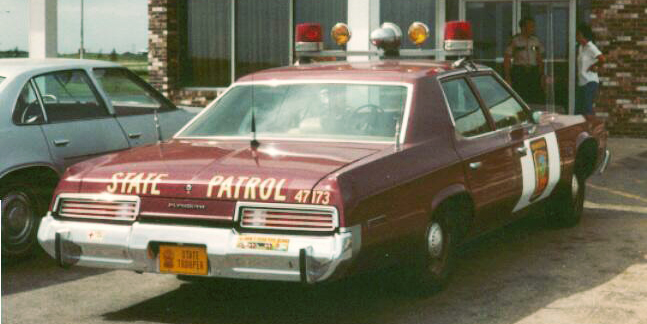
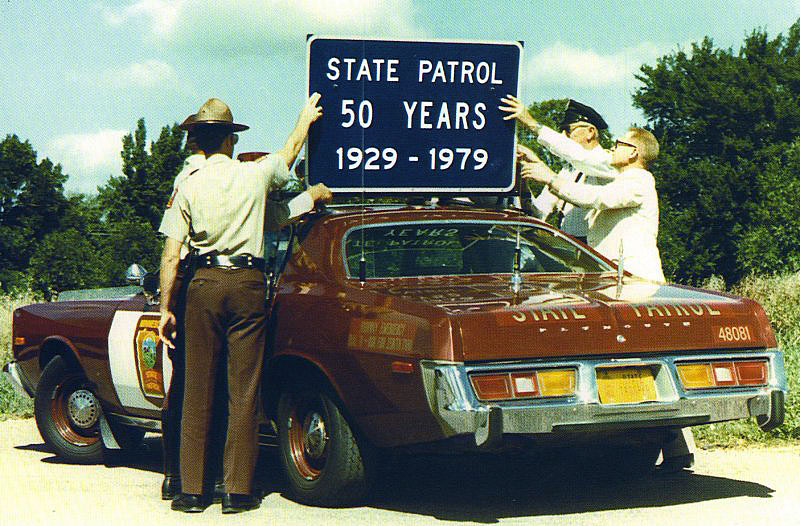
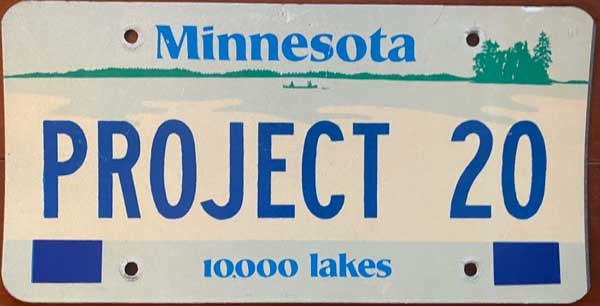 See description to the right.
See description to the right.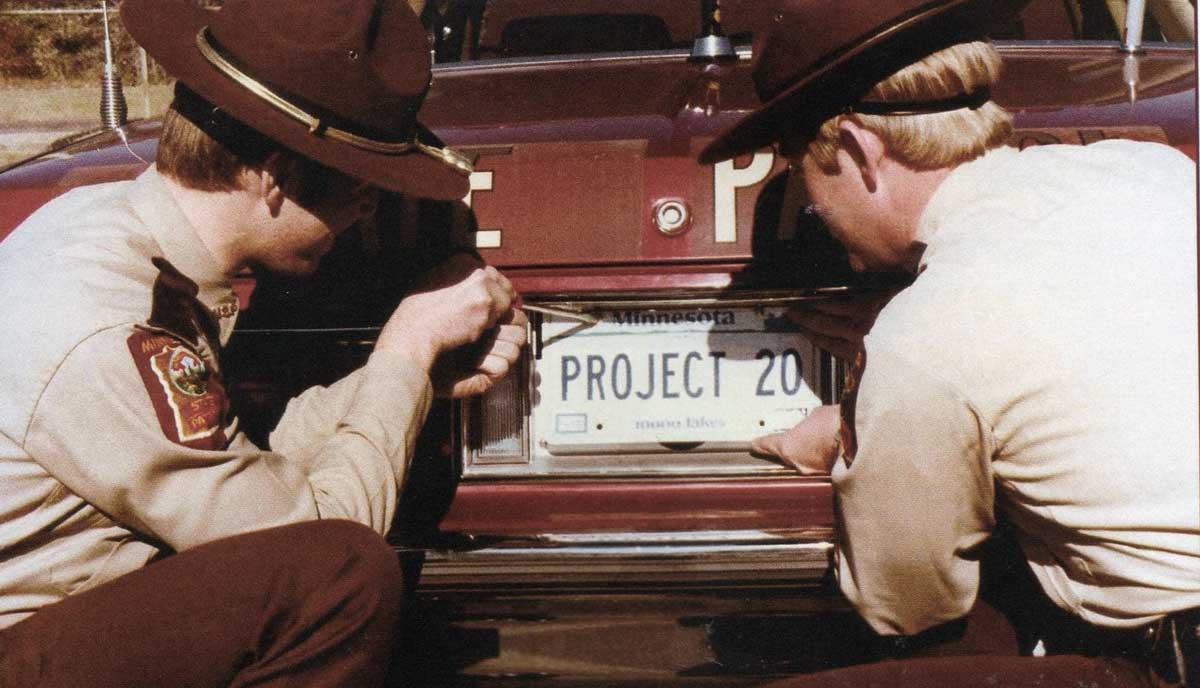 Putting it on, or taking it off?....either way: there's focus on the task !
Putting it on, or taking it off?....either way: there's focus on the task !Around 1983, the MSP was issued with new license plates replacing the older "badge plates". The new plates were embossed galvanized steel and painted dark blue over reflective gold. The state name was situated between the upper mounting holes and the state slogan 10,000 LAKES was situated between the lower mounting holes. The center of the plate is occupied by the title STATE over TROOPER.
These license plates were displayed on marked MSP vehicles until 1987 and were run front and rear.
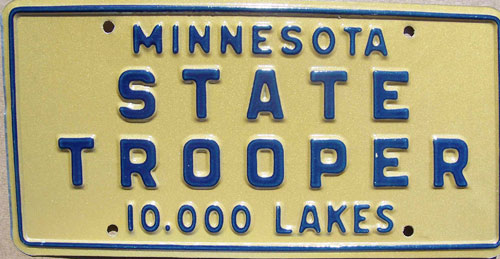 1983-1987 issue.
1983-1987 issue. 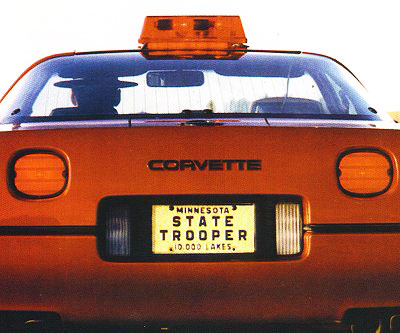
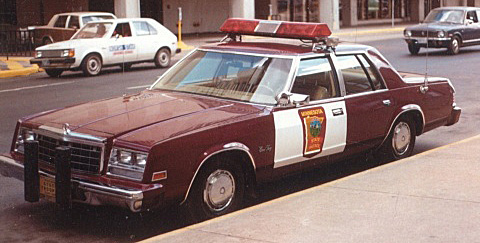
1987 saw the replacement of the 1983 galvanized steel MSP license plates with a flat silkscreened aluminum plate with a debossed step border. The plate is spartan in design with only STATE over PATROL in maroon screened over a reflective gold base.
This version was known as the "Plain Jane" version and only used for one year.
It has been stated that a legal issue required the words "State Patrol" to be displayed on the rear of marked MSP vehicles, and that this was the easiest/quickest solution at the time. Unissued stock of the plate were issued to be run on the front of MSP vehicles running the 1988 replacement issue on the rear.
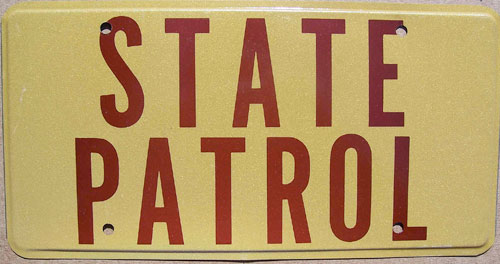 1987-1988 issue.
1987-1988 issue. 
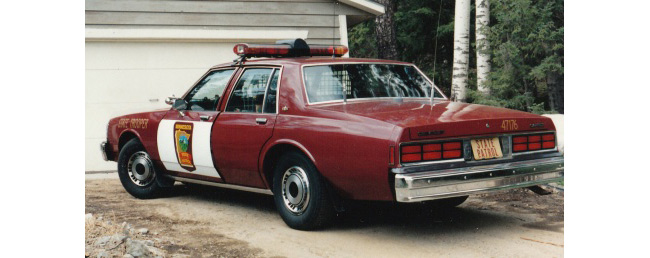

The unpopular "Plain Jane" license plate was phased out in favor of a more attractive replacement during the week before the Indianapolis 500 in 1988. The newly-launched plate was not only fastened, but RIVETTED to an MSP car that was sent to the event at the Brickyard. The new plates were reminiscent of the 1983-1987 issue using embossed galvanized steel and ALL were rivetted in place as an anti-theft measure.
This issue was painted maroon over reflective gold.
The state name is situated between the upper mounting holes and the state slogan 10,000 LAKES is situated between the lower mounting holes. The center of the plate is occupied by a small embossed silhouette of the state on the left portion of the plate followed by the title STATE over PATROL.
These license plates were issued to marked MSP vehicles until approximately 1991.
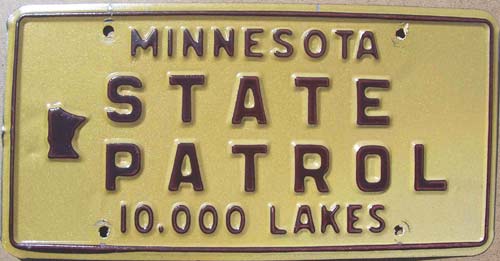 1988-Circa 1991 issue.
1988-Circa 1991 issue. 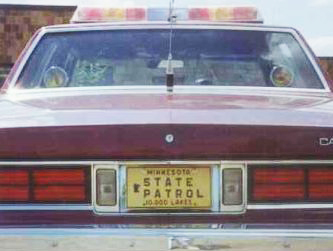
 (Courtesy Kyle Helvig)
(Courtesy Kyle Helvig)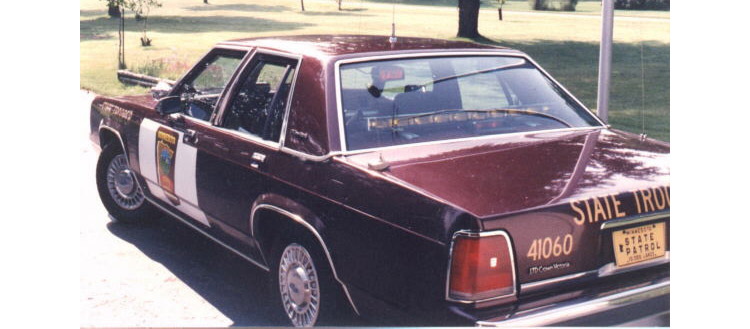
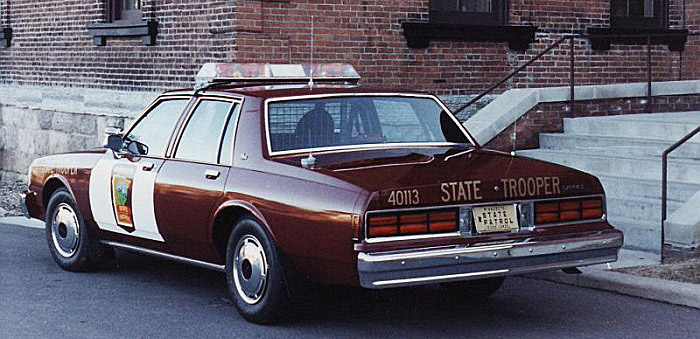
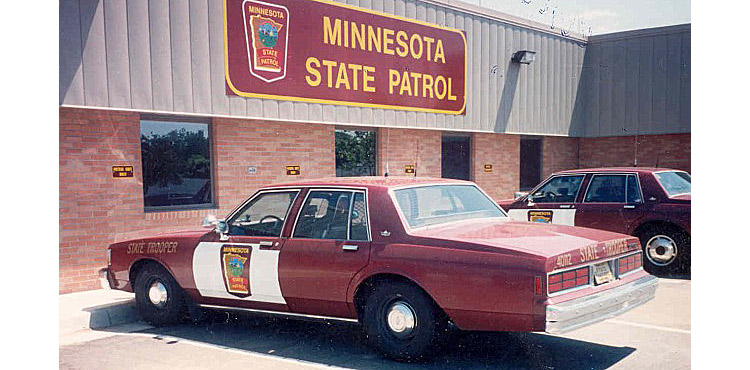
As the 1990's began, the MSP decided to introduce a license plate featuring the emblem of the MSP as seen on the uniform shoulder patch.
The initial layout was an embossed steel plate in maroon over reflective white.
A full color decal was applied and centered between the upper and lower left mounting holes.
The title STATE over PATROL was situated in the center right field of the plate.
This earliest of issues had the state name embossed between the lower mounting holes.
It is unknown if this issue went to full roll-out as so few of these examples are known in current existence.
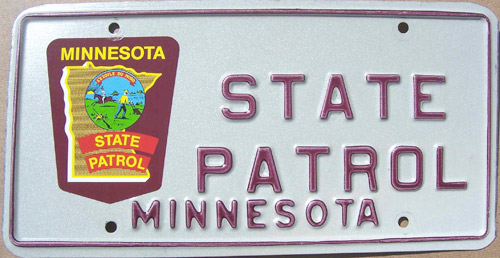 Early 1990 issue. Embossed steel.
Early 1990 issue. Embossed steel. 
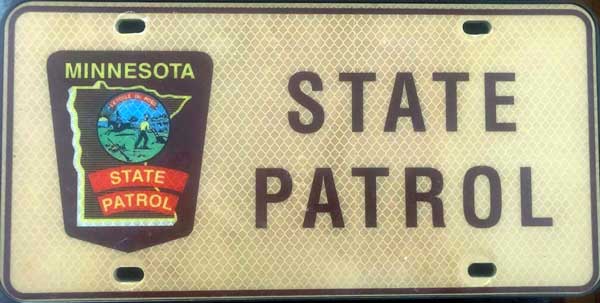 Circa 1990 Experimental design/layout from 3M tested in Stillwater District.
Circa 1990 Experimental design/layout from 3M tested in Stillwater District.
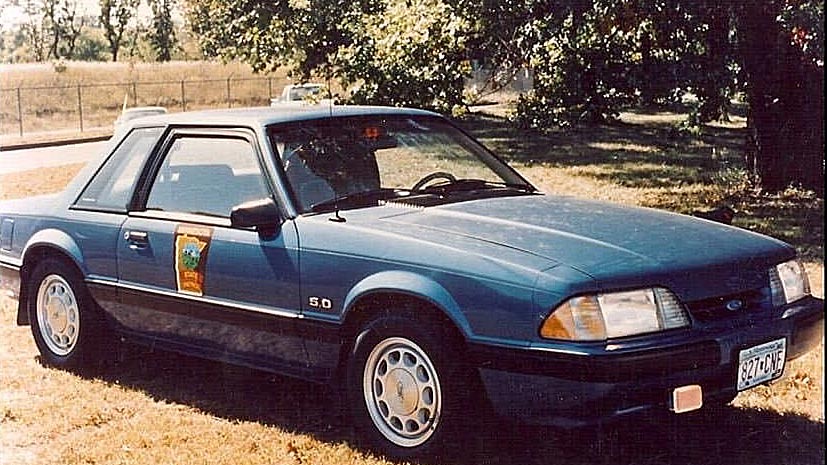 SSP Mustang with regular passenger license plate 827-CNF
SSP Mustang with regular passenger license plate 827-CNF By 1991, the "Patch Plate" dropped the embossed state name and reverted to the reflective gold background. The layout utilizing the MSP shoulder path emblem decal was maintained as was the postioning of STATE over PATROL.
It's believed that the state name was dropped as it was redundant and made the plate appear too crowded. This newer issue provided a cleaner appearance and stayed true to the tradition of a gold colored background.
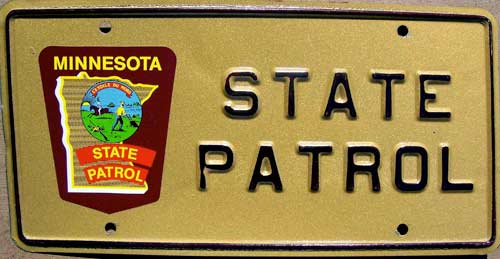 1991-1999 issue.
1991-1999 issue. 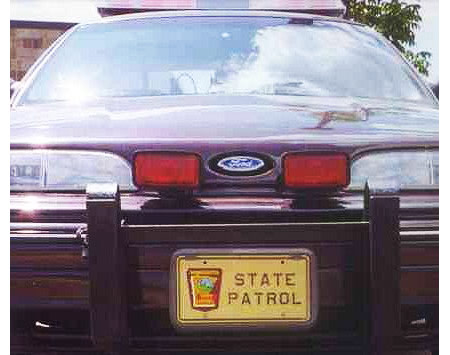
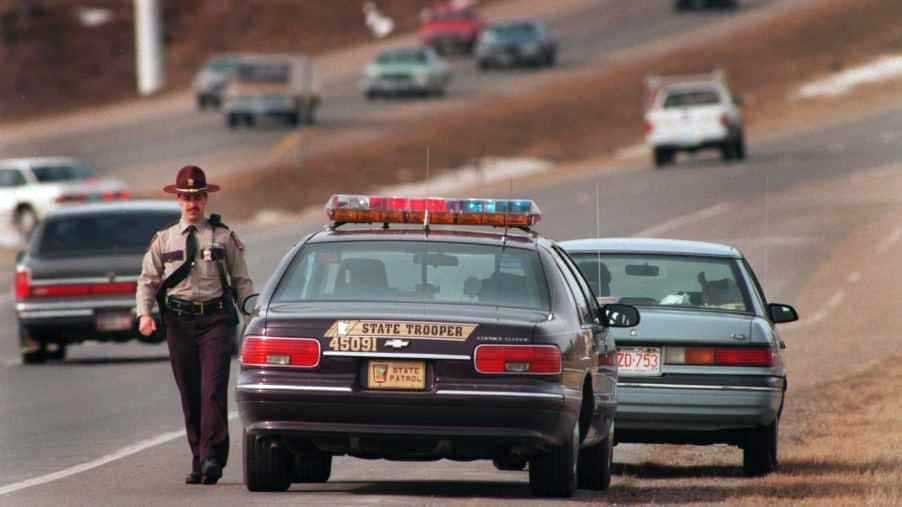 Nailed another guy from Wisconsin !
Nailed another guy from Wisconsin !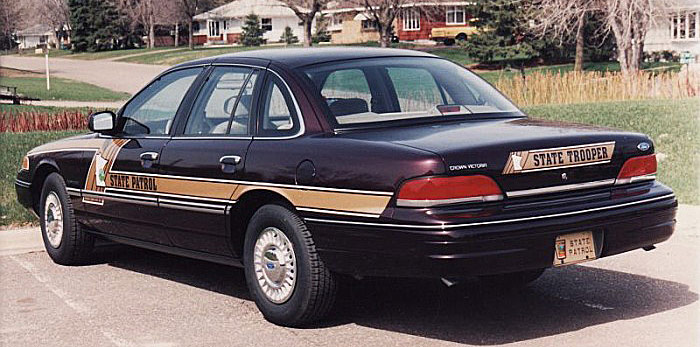
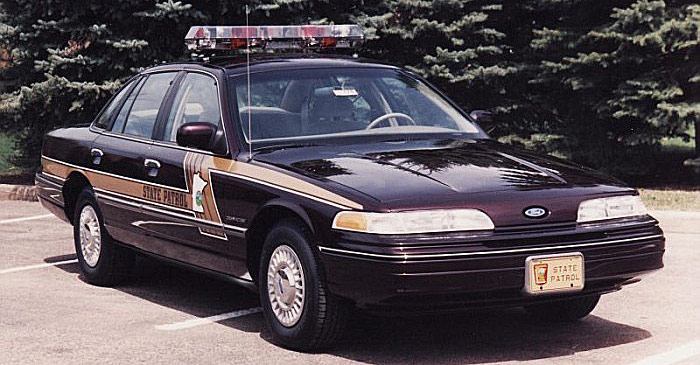
By 1999, the MSP switched to an embossed aluminum plate using the same layout with the exception of a step border instead of a painted raised border. These plates also featured subdued manufacturing holograms featuring the silhouette of a loon and the production number.
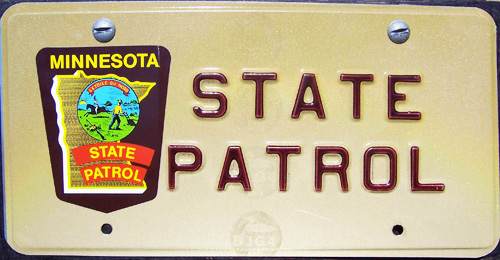 1999-2010 issue. Embossed aluminum.
1999-2010 issue. Embossed aluminum. 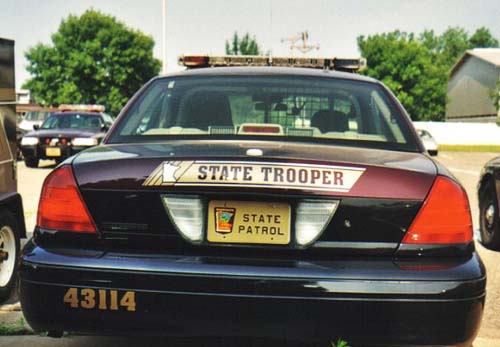
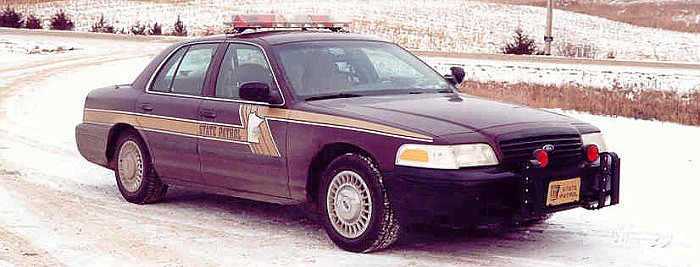
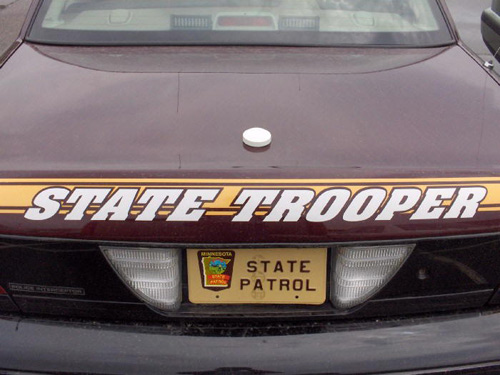
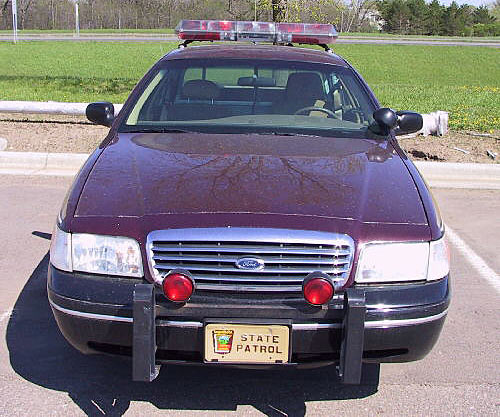
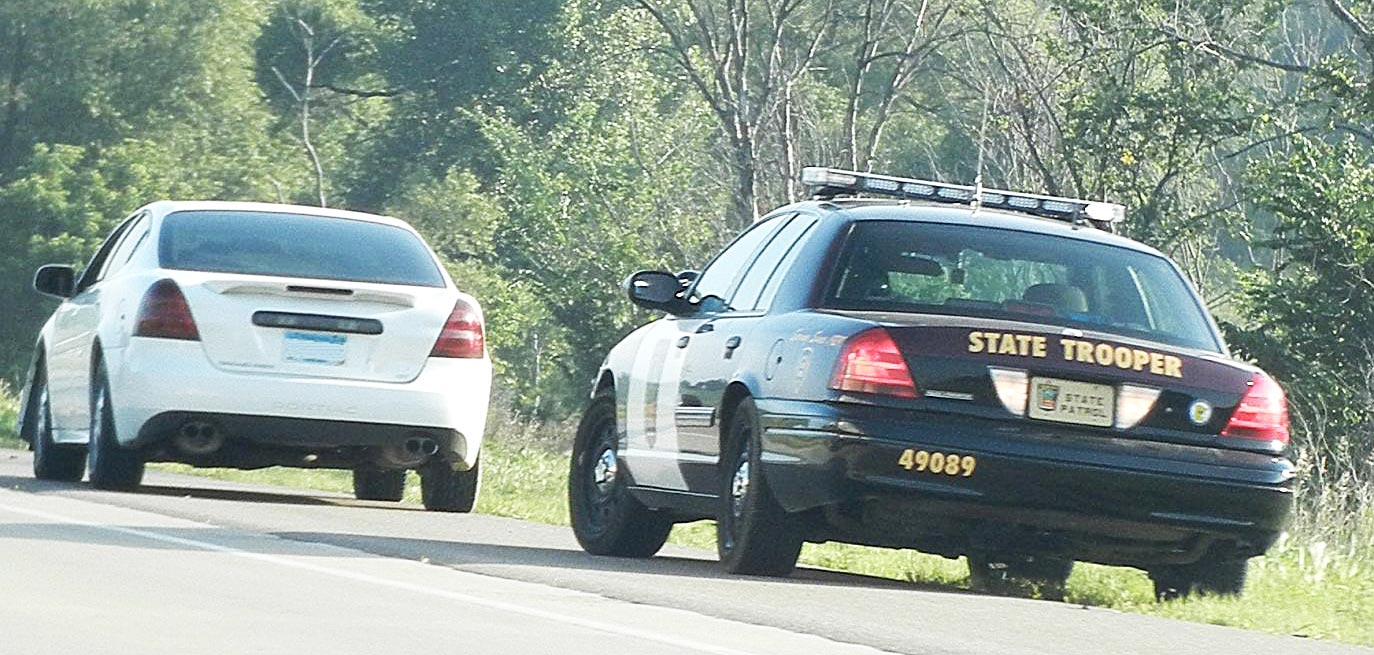
The Minnesota State Patrol celebrated 75 years in 2004. As one of the agency's commemorative efforts for this milestone event, special license plates were issued for all marked MSP vehicles.
The plates were flat aluminum and once again reflective gold. The MSP shoulder patch insignia continued to occupy the left side of the plate. The right side of the plate is occupied by a large applied decal featuring the image of the MSP campaign hat emblazoned with 75 years. MINNESOTA STATE PATROL spans the curvature above the hat image and 1929-2004 is situated below the hat and above the lower right mounting hole.
These plates were used only for the anniversary year and replaced by the 1999 issue plates which were kept in storage during 2004.
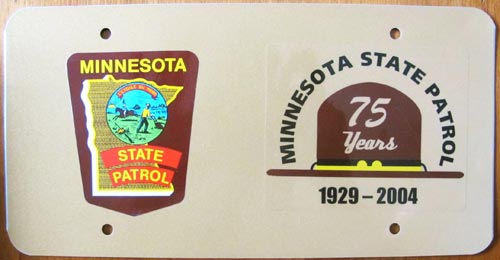 2004 75th Anniversary issue.
2004 75th Anniversary issue.  Car 44161 indicates a 2004 manufacture year.
Car 44161 indicates a 2004 manufacture year. Mid-way through 2006, the MSP decided to issue special license plates to be used on the front of marked MSP vehicles involved with DWI (Driving While Impaired) Enforcement. These front plates were embossed aluminum and colored in the traditional maroon over reflective gold. The plate features a raised border with DWI in large dies located in the field of the plate between the upper mounting holes and ENFORCEMENT embossed in smaller dies situated across the plate just above the lower mounting holes.
These plates were used concurrent to the 1999 MSP license plate which was also run on the front as well as the rear of the marked MSP vehicles through the early 2000's.
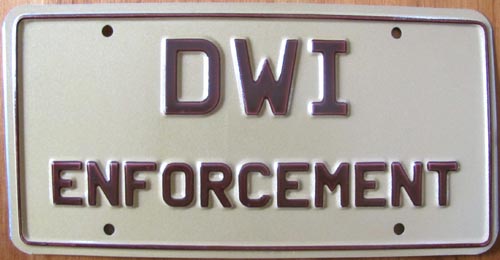 Circa 2006 issue front plate.
Circa 2006 issue front plate. 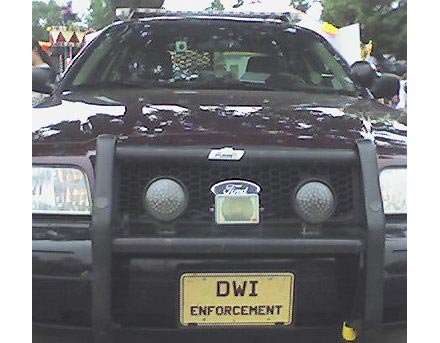
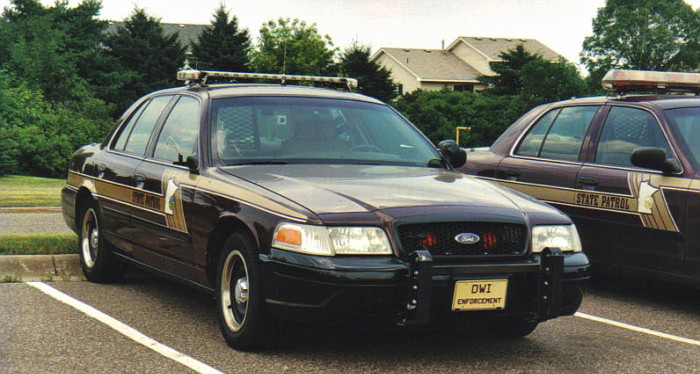
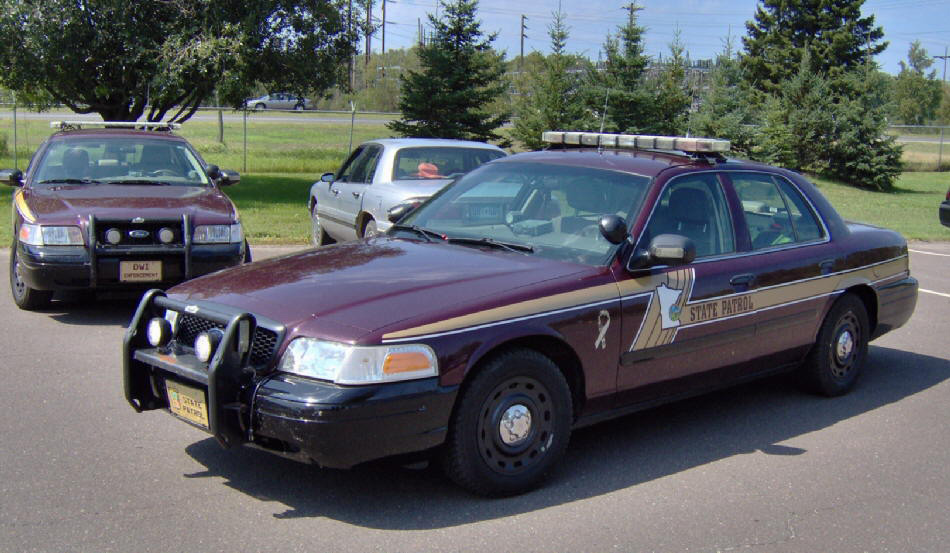
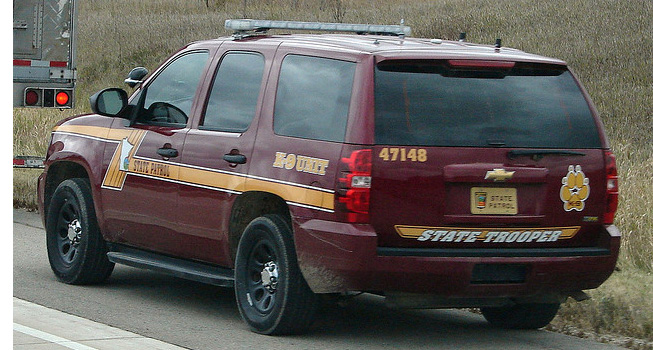
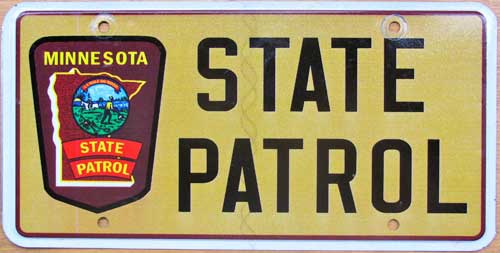 2010-2024 issue.
2010-2024 issue. 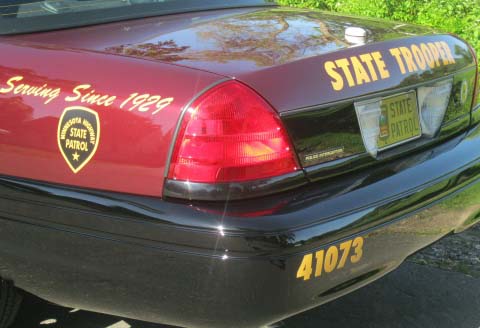
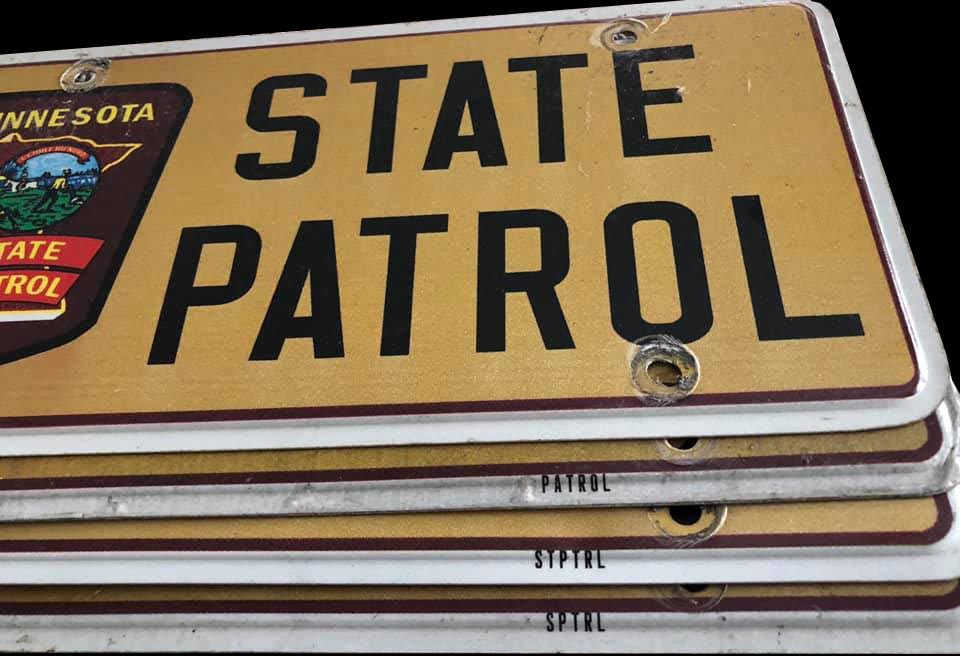 Stack of 2010-2024 MNSP license plates showing variety of border markings used. (PATROL STPTRL and SPTRL)
Stack of 2010-2024 MNSP license plates showing variety of border markings used. (PATROL STPTRL and SPTRL) 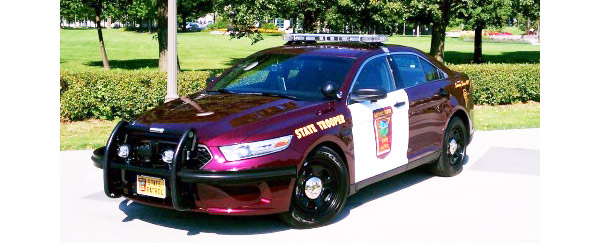

In the 2023 session of the Minnesota state legislature, it was decided that the existing state seal and flag was "offensive" to some people and therefore warranted a change. On May 11 2024, the Great Seal and flag of Minnesota were changed to quell the "upset" over the existing iterations. The new seal eliminated the "offending imagery" and replaced it with a single white star against a blue backdrop of sky and water.
By the Summer of 2024, the license plates of the Minnesota State Patrol were changed to reflect this new motif.
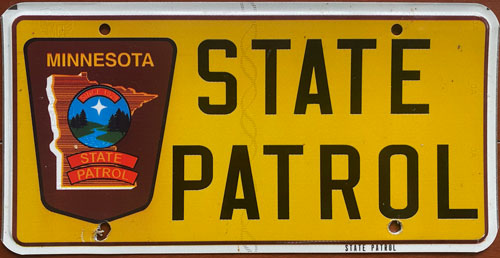 Summer 2024-Current issue.
Summer 2024-Current issue.
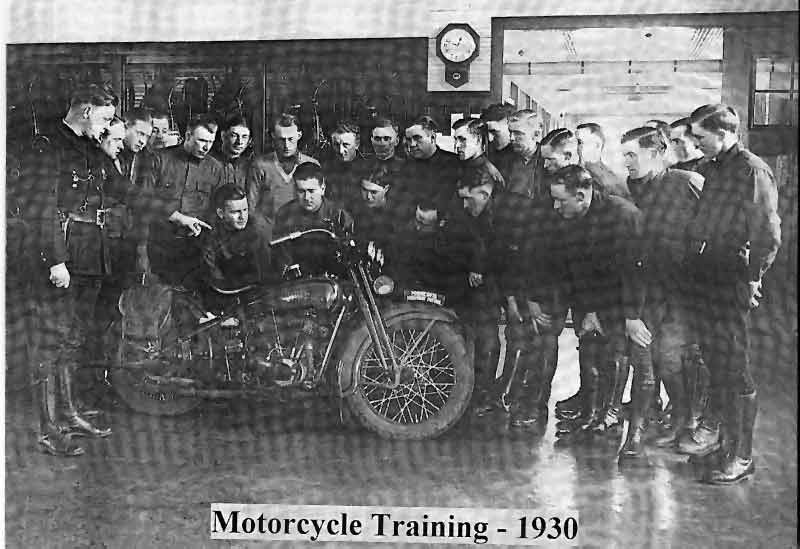
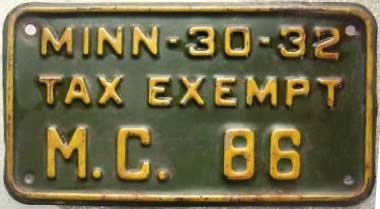 1930-1932 motorcycle issue.
1930-1932 motorcycle issue.
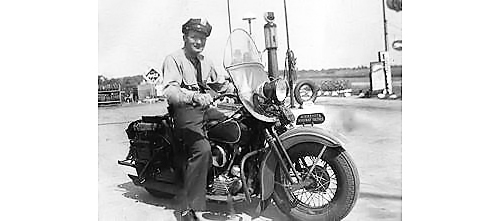
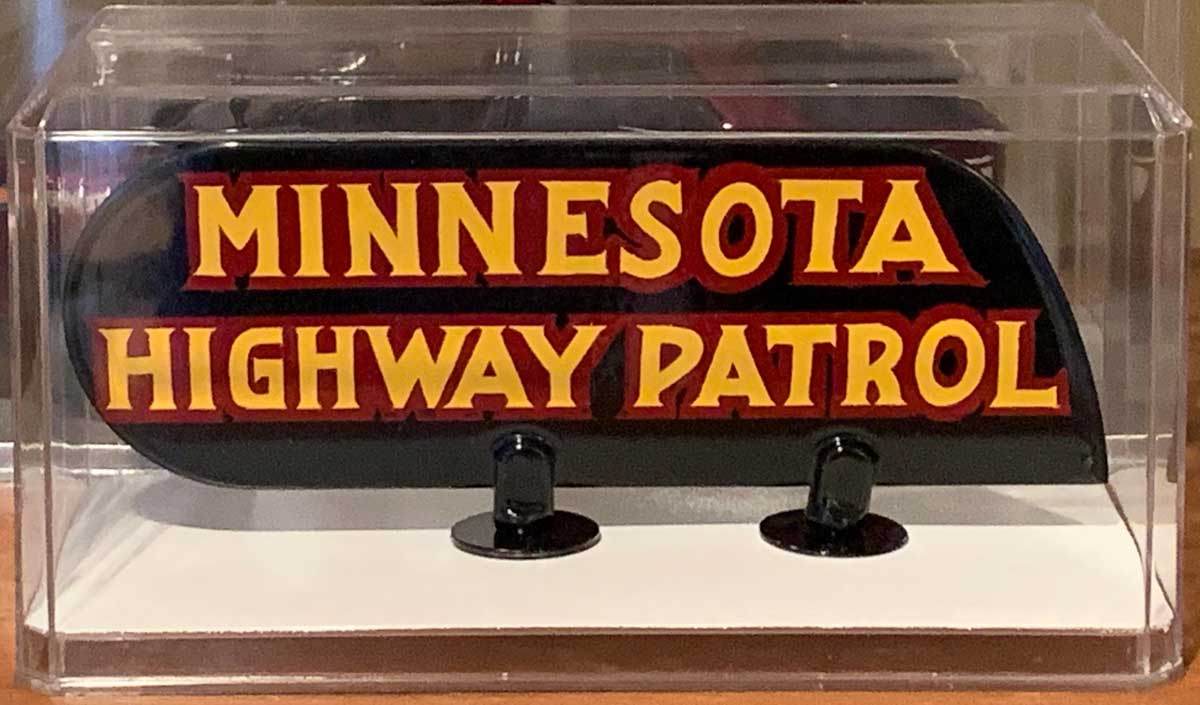 Vintage Minnesota Highway Patrol fender sign.
Vintage Minnesota Highway Patrol fender sign.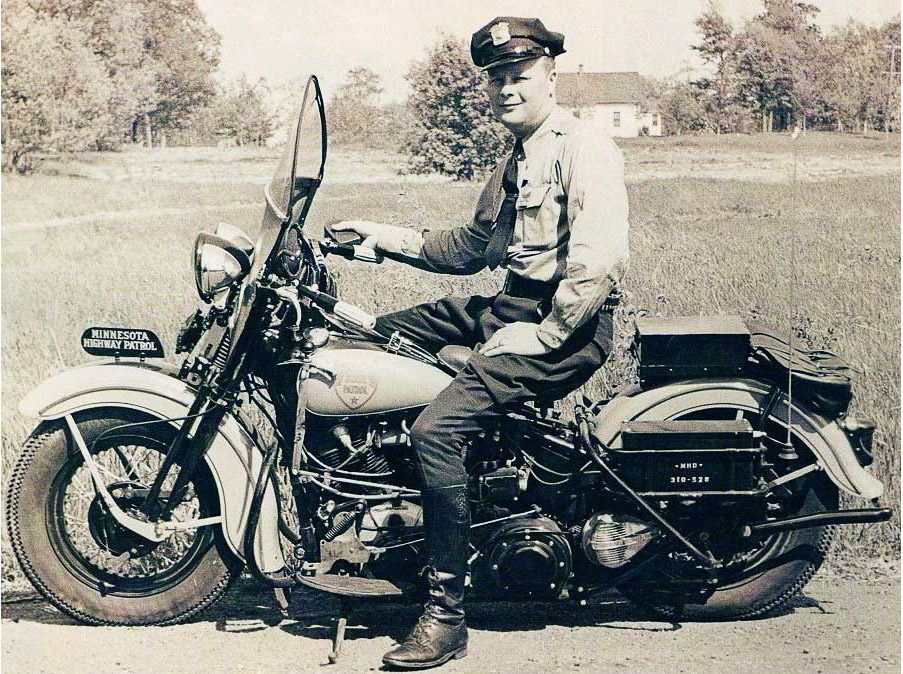
License plates used by early MSP motocycles were never properly documented. Motorcycles were used on patrol from the MSP's inception in 1929 and phased-out by 1949 before their re-introduction in 2007.
The photographic proof for the front fender title plates on early MSP motorcycles shown is clear with such devices showing them marked as MINNESOTA over HIGHWAY PATROL. They were screen-painted gold over black and painted on both sides.
As for the license plates run on the rear of these vehicles: we don't know yet.
The one photo shown earlier on this page displaying a 1948 motorcycle parked next to a 1948 MSP patrol car shows a plate with what appears to have a MC prefix followed by a 2 digit number.
It also appears to have a title along the top that says TAX EXEMPT and what is likely the state name along the bottom. This is the only clear example of what was run on MSP motorcycles before their disbandment in 1949.
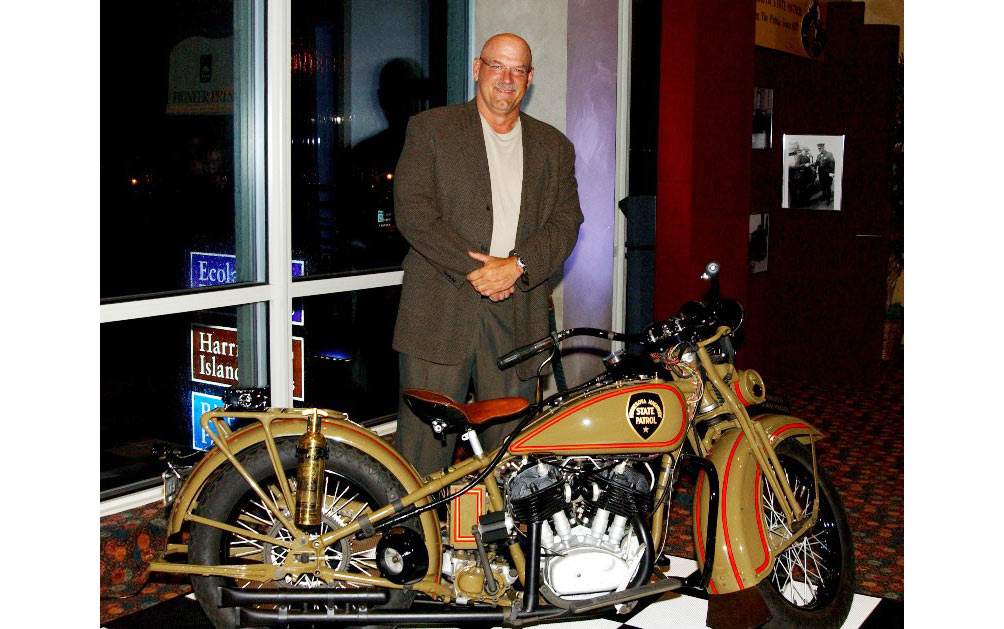
The license plate shown below is a special-made plate for restored MSHP motorcycle seen above with former Minnesota Governor Jesse Ventura.
Dark blue over reflective gold on embossed aluminum with PATROL embossed in the center field of the plate with the state name along the top and 10000 LAKES embossed along the bottom.
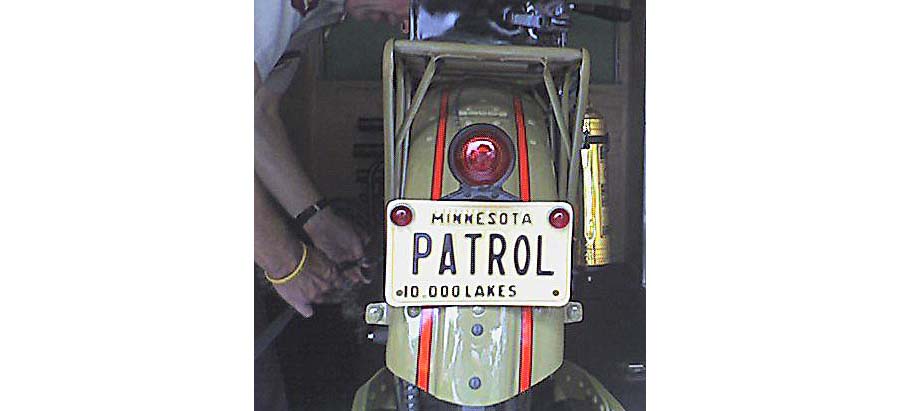
In 2007, the Minnesota State Patrol re-launched motorcycles as part of their fleet.
Five members qualified for selection to the new Unit and underwent training school with the St. Paul Police Department.
The MSP Motor Unit was based in the Minneapolis-St. Paul metro area and saw regular use on metro freeways from April until November.
The five new "motors" were outfitted with silkscreened vinyl license plates which were spearheaded by MSP Trooper Eddie Carroll. They measured roughly 4 inches high by 7 inches across. The plates were screened with a reflective gold background with a black border outline and numerals. The numerals are the 5 digit "Squad Number" reflecting the state auditor code number for the vehicle with the 4 prefix for MSP.
The state name is situated in maroon at the top of the plate and STATE PATROL is situated at the bottom of the plate in the same color.
The assignment number is prefaced by the "winged wheel and arrow" motif reminiscent of motorcycle patrols of yore in gold, red, white and black.
Despite the effectiveness of MSP's Motor Unit, in 2012, due to manpower and logistical challenges, the Motor Unit was sadly disbanded.
"On duty photos" from those great years shown below are thanks to Tpr. Eddie Carrol.
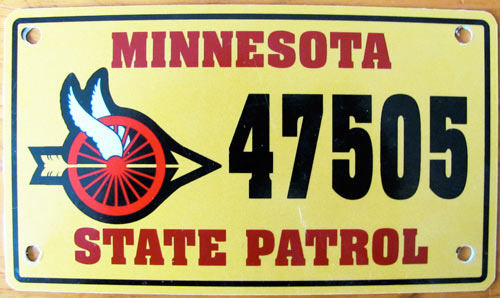 2007-2012 motorcycle issue.
Screened vinyl.
2007-2012 motorcycle issue.
Screened vinyl. 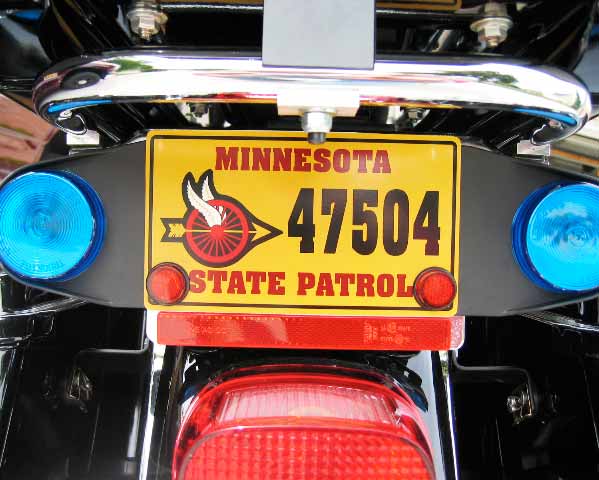
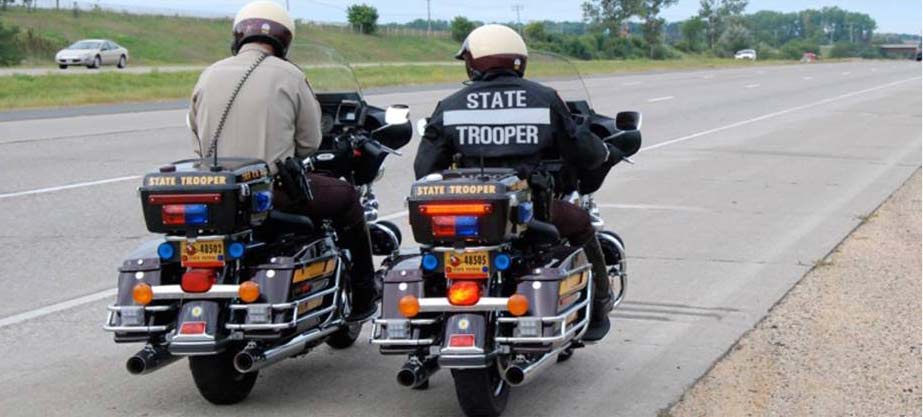 (Courtesy Scott Reichel)
(Courtesy Scott Reichel)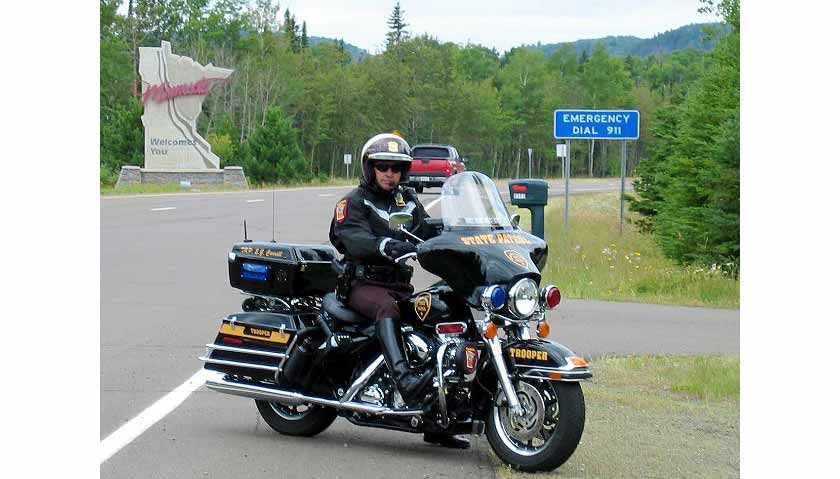
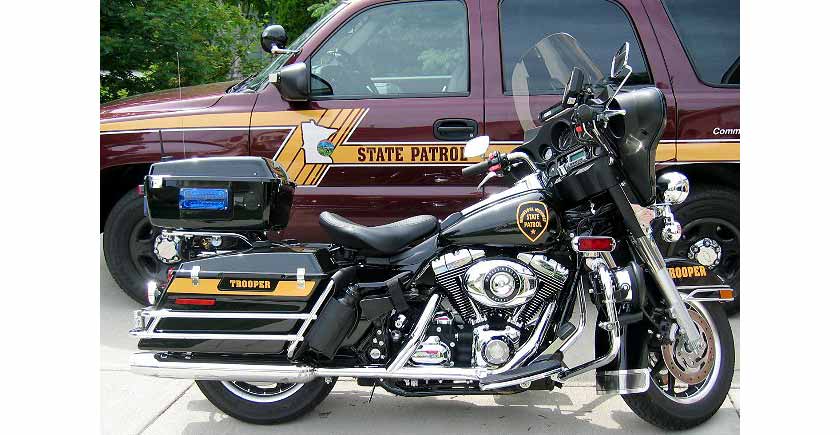
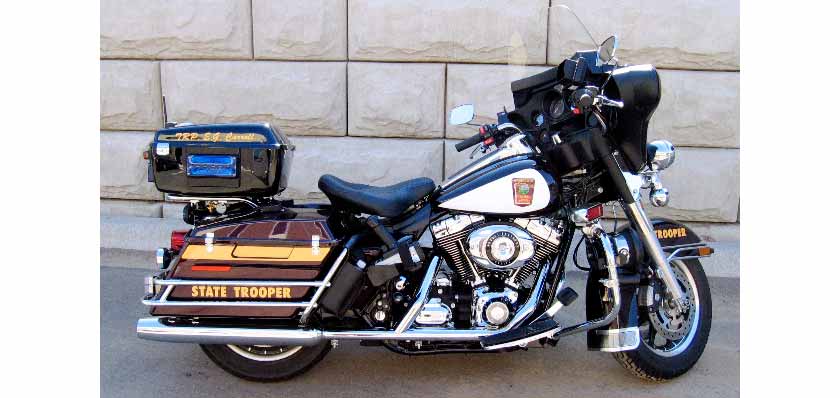
This section is dedicated to special issue license plates related to the Minnesota State Patrol but not official duty issues.
 Stated to be a front license plate used by MSP in 1970's
Stated to be a front license plate used by MSP in 1970's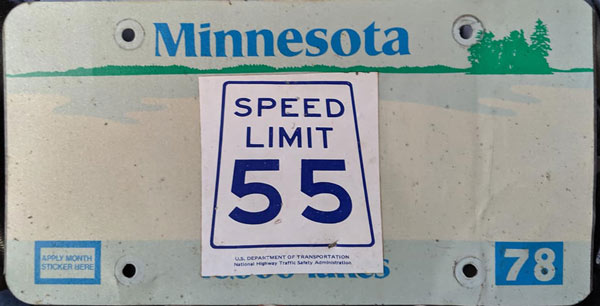 1978-1979 Speed Limit decal affixed to blank passenger plate.
1978-1979 Speed Limit decal affixed to blank passenger plate. 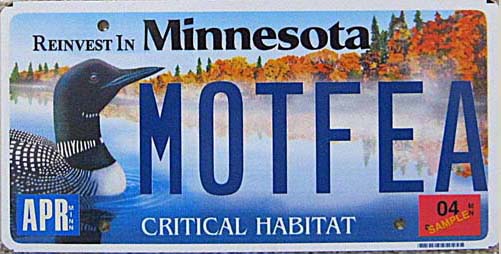 Midwest Odometer and Title Fraud Enforcement Association conference souvenir license plate. The April 0f 2004 MOTFEA conference hosted by MSP issued these attractive souvenir license plates for delegates in attendance.
Midwest Odometer and Title Fraud Enforcement Association conference souvenir license plate. The April 0f 2004 MOTFEA conference hosted by MSP issued these attractive souvenir license plates for delegates in attendance.